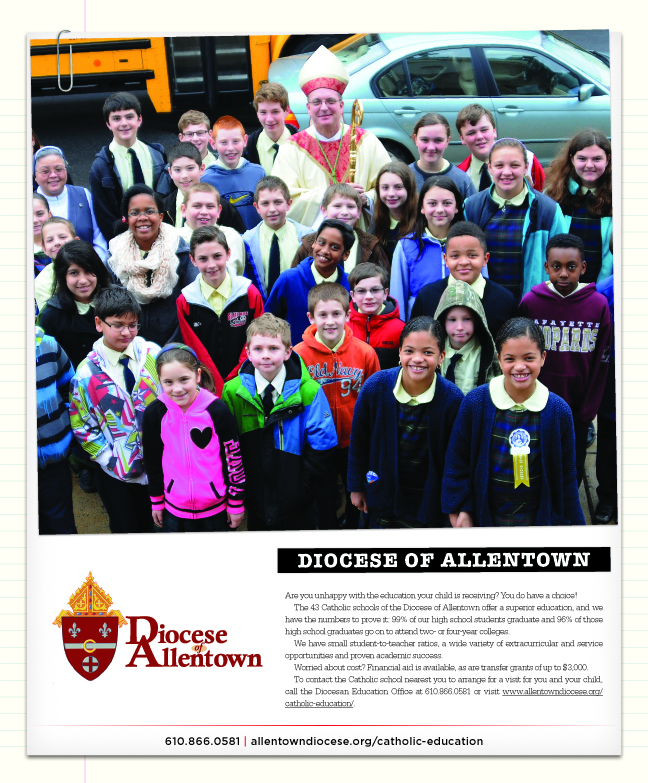“Sometimes the first step toward success is knowing that what you’re doing now is not working. You can believe passionately in Catholic schools. But ultimately, you must be willing to challenge age-old practices.”

Tuition Transfer Grants
Catholic elementary and high schools issued 520 grants through the Diocese of Allentown’s Tuition Transfer Grants (TTG) Program last year. The program began with testing in 10 volunteer schools leading up to the 2011-12 school year. By 2015-16, 27 of 35 elementary schools (77%) and all six high schools (100%) participated.
“This program is precisely the kind of innovative application of a business principle that today’s Catholic schools need,” said Jason Morrison, Vice President of Operations, Healey Education Foundation. “To remain competitive, schools must do business differently. This is one of many ways to help our schools grow.”
How They Work

The Diocese has employed a range of marketing channels to promote Tuition Transfer Grants. Among them: billboards, print and TV ads, direct mail, eNews, school Open Houses, social media and parish bulletin updates.
The Tuition Transfer Grants program has delivered one of the most successful outcomes ushered in by the Bishop’s Commission on Catholic Schools (BCCS), established in 2010 to change the economic and business operating principles of the school system. Research had confirmed that diocesan schools were delivering superior academic outcomes and a strong faith education. But BCCS recommended a two-pronged strategy to reverse enrollment declines over 15 straight years: market aggressively and offer financial aid.
Modeled after the successful college grant program offered by Alvernia and DeSales Universities, the diocesan program attracts new students through a relatively small financial incentive that motivates parents to consider Catholic schools. The Diocese offers grants to public, private or charter school students who transfer. Elementary students in grades 1-7 are eligible to receive $1,500 in grants ($1,000 in year 1 and $500 in year 2). High school transfers in grades 10 and 11 are eligible to receive $3,000 in grants ($2,000 in year 1 and $1,000 in year 2).
Why They Work
- In a school operating below capacity, each empty seat has no economic value. As explained by BCCS co-chair Mark Lieberman, a classroom with empty seats is similar to an airplane with empty seats: many fixed costs, remaining economic potential and ready for takeoff.
- Bringing in more students, even at reduced tuition, can improve finances.
- Tuition Transfer Grants are smart marketing. A significant portion of public, private and charter school parents and students are not happy with their current education option; Catholic schools can reach out and incentivize this transfer market. In promoting the grants, the school shares its mission and attracts inquiries and visits from a broader audience that may have felt a Catholic school is unaffordable.
Building Support
When introducing Tuition Transfer Grants, the school community must be on board: pastors, presidents, principals, advancement and admissions staff, board members, faculty and families. “If school leaders wonder about the economic feasibility of the Transfer Grants, once they understand the fixed cost scenario of expenses, they are open to discounting,” said Philip J. Fromuth, Ph.D., Superintendent of Catholic Education, Diocese of Allentown.
“For existing families who are not eligible for the Transfer Grant, their tuition is already partially subsidized by the supporting parishes at the elementary level and diocese at the high school level. All families, existing or new, may apply for available tuition assistance,” he said. “Also, new students produce new revenue that lessens necessary tuition increases and supports new or existing programs at the school. The Transfer Grant Program is truly a win/win for schools and families.”
The faculty, too, must be involved and supportive. As enrollment increases, they need to prepare for larger class sizes and shifting learning needs in their classrooms.
Outcomes
In the Diocese of Allentown data for 2015-16:
- 27 participating elementary schools issued 389 grants
- The average number of grants per elementary school was 14 (an increase over 12 the prior year)
- 6 high schools issued 131 grants
- The average number of grants issued per high school was 22 (an increase over 17 the prior year)
For each of the first four years of the program, the diocese added a whole new school’s worth of transfer students.
The Healey Education Foundation promotes and supports the program among its partner schools. In the Diocese of Allentown, six Healey partner schools were among the top seven elementary schools based on number of new TTG students enrolled. Together, those six schools enrolled 197 TTG students. Four Healey partner high schools awarded a combined 91 grants.
Sharing the Joy and Best Practices

Also see the Tuition Transfer Grants Case Study featuring the approach and outcomes achieved by Healey partner Mother of Providence Regional Catholic School (Wallingford, PA). The school designed its program adopting successful practices from the Diocese of Allentown.
The success of the Diocese of Allentown’s program has extended beyond its geographic borders. Together and individually, the Diocese and Healey have shared the concept of Tuition Transfer Grants with others, including partners in the Archdioceses of Philadelphia and Baltimore.
Fromuth has fielded calls about Tuition Transfer Grants from Catholic school leaders around the country. He recalls several discussions following the publication of an article written by Lieberman about the diocese’s program featured in NCEA’S Momentum.
Lieberman recently heard from a former BCCS member about a school in northern California now applying some of the approaches. “The Tuition Transfer Grants Program was one of three marketing trials that we started. Part of marketing is trial and error, and this one knocked it out of the park,” he said. “It’s refreshing to know that what we’ve learned is also making a difference for other Catholic schools.”
“Tuition Transfer Grants are smart marketing. Beyond that, this program has helped open the minds of principals and pastors to the idea of discounting. To truly evangelize, we need new families and students in our schools.”
